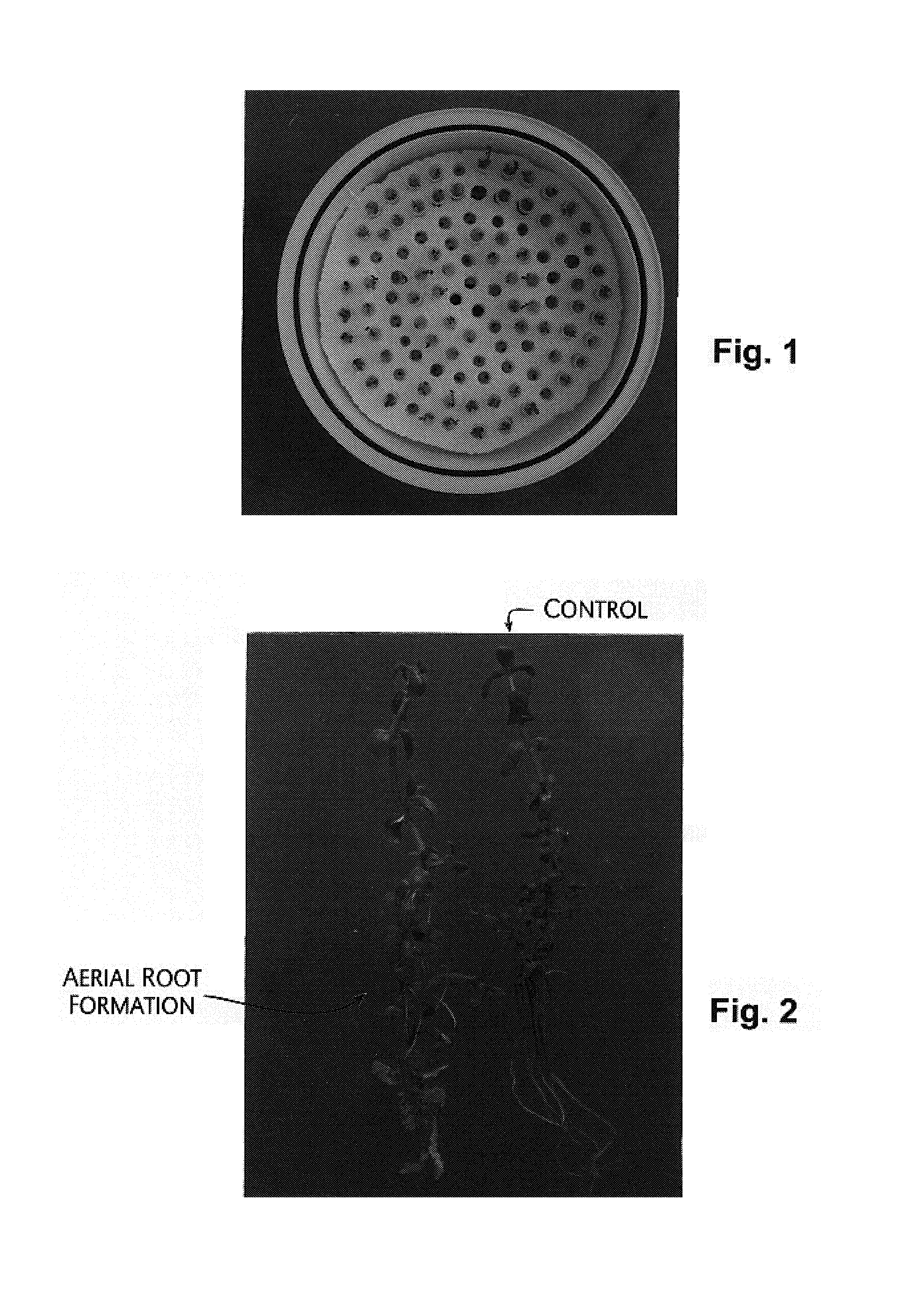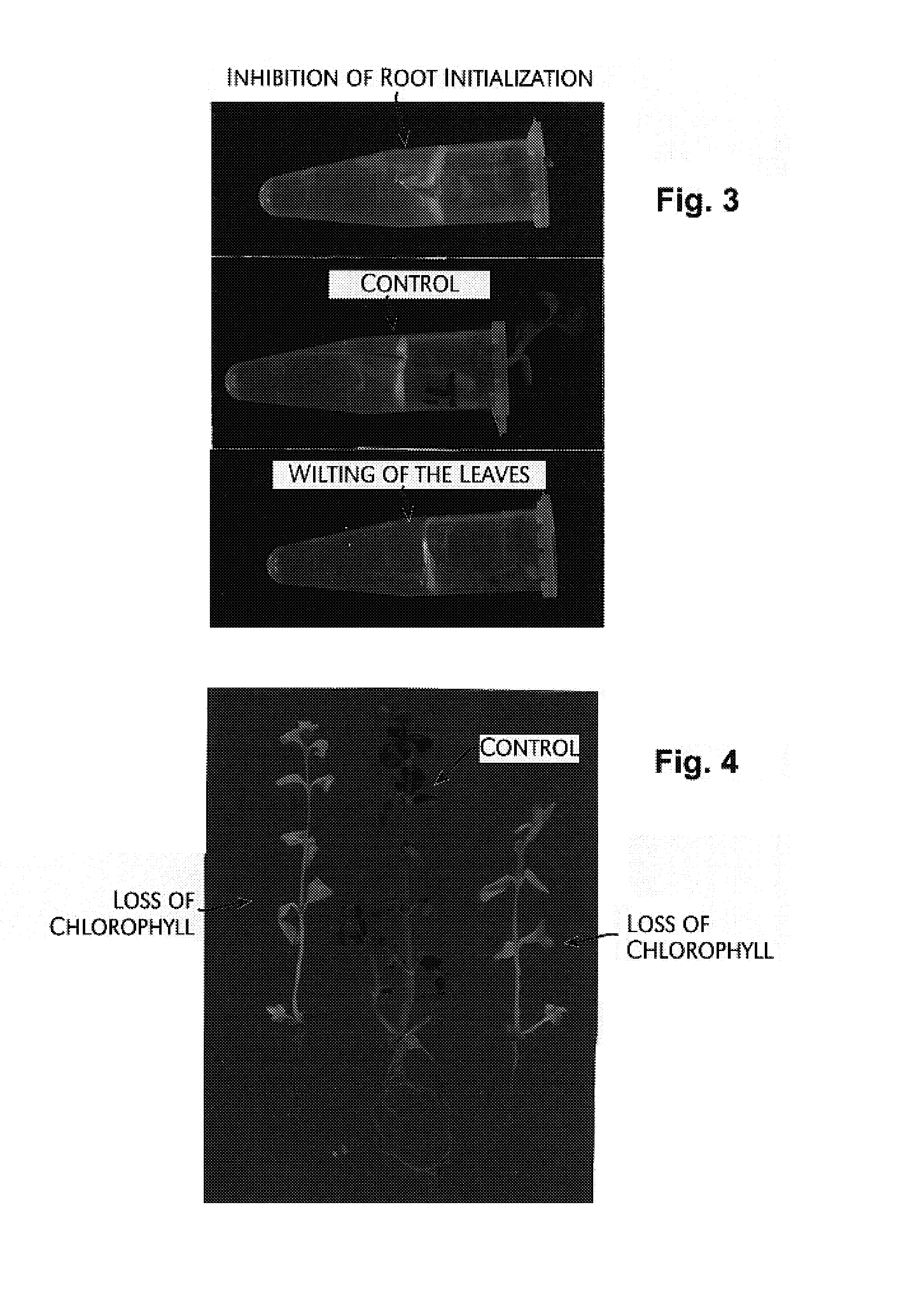Plant test procedure to detect natural, semi-synthetic, synthetic compounds and physical stress factors through expression of distinct responses
a plant test and response technology, applied in the field of plant test procedures to detect natural, semi-synthetic, synthetic compounds and physical stress factors through expression of distinct responses, to achieve the effect of convenient, rapid and repetitive manner, and applicability in assessing
- Summary
- Abstract
- Description
- Claims
- Application Information
AI Technical Summary
Benefits of technology
Problems solved by technology
Method used
Image
Examples
example 1
[0062]To find out the effect of growth promoters such as Indole 3 acetic acid (IAA), 2,4-Dichlorophenoxy acetic acid (2,4-D), and cytokinins such as 6-Benzyl Amino Purine (6-BAP) and Kinetin, the leaf, internode and twig cuttings were inoculated into MS 0 medium containing 1 mg / ml of the above said compounds and the responses were recorded up to two weeks in terms of rooting, callusing and shoot regeneration (Table 1). This defined the typical response, which were obtained in individual examples / treatments. The unique features were aerial root formation in the case of cuttings upon auxin treatment as shown in FIG. #2 of sheet #1. On the other hand, in the case of cytokinin BAP green callus has formed, followed by shoot regeneration from leaf and internodal explant. The findings were suggestive of the use of these responses in assessing compounds for cytokinin and auxin like activities.
[0063]Table 1 summarizes the response recorded up to two weeks in terms of rooting, callusing a sho...
example 2
[0065]The effects of growth inhibitors were also tested using the protocol as described in Example 1. In this experiment, the twigs were in the basal MS media containing Nalidixic acid (Nal) at the rate of 10 μg / ml and 100 μg / ml and the effects were observed after 10 days of inoculation. In the case of the 10 μg ml concentration of nalidixic acid, the roots got initiated from the submerged nodes but their growth was less than the control MS basal medium. While in the case of 100 μg / ml concentration of nalidixic acid, very small roots arose from submerged node and their growth was completely arrested.
example 3
[0066]The conditions were standardized for root tip assays to determine the effect of compounds like taxol on cell division. The following example gives the experimental procedure, which was followed and found suitable for determining cell division initiation in the roots initiated from twig cuttings of Bacopa as described in general methodology on day 7. The fresh initiated roots in MSR medium were dipped in micro-centrifuge tubes containing MS broth with solvent (DMSO or likewise), the compound (taxol dissolved in DM50 or likewise) and control (MSR broth). The dipping treatment was continued for 3 hours after which the root tips were cut and fixed in a 1:3 solution of glacial acetic acid and absolute alcohol and the fixation was continued for 24 hrs at room temperature. For long term storage such roots could be stored in 90% ethanol. For further processing these fixed roots tips were treated with 5 N HCl for 10 mm followed by thorough washing with sterile distilled water (3 to 4 t...
PUM
| Property | Measurement | Unit |
|---|---|---|
| diameter | aaaaa | aaaaa |
| concentrations | aaaaa | aaaaa |
| temperature | aaaaa | aaaaa |
Abstract
Description
Claims
Application Information
 Login to View More
Login to View More - R&D
- Intellectual Property
- Life Sciences
- Materials
- Tech Scout
- Unparalleled Data Quality
- Higher Quality Content
- 60% Fewer Hallucinations
Browse by: Latest US Patents, China's latest patents, Technical Efficacy Thesaurus, Application Domain, Technology Topic, Popular Technical Reports.
© 2025 PatSnap. All rights reserved.Legal|Privacy policy|Modern Slavery Act Transparency Statement|Sitemap|About US| Contact US: help@patsnap.com


